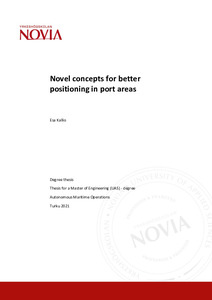Novel concepts for better positioning in port areas
Kallio, Esa (2021)
Kallio, Esa
2021
All rights reserved. This publication is copyrighted. You may download, display and print it for Your own personal use. Commercial use is prohibited.
Julkaisun pysyvä osoite on
https://urn.fi/URN:NBN:fi:amk-2021120323575
https://urn.fi/URN:NBN:fi:amk-2021120323575
Tiivistelmä
As the maritime traffic gradually becomes more automated in the following years and decades, the shortage of human perception onboard must be compensated with alternative means. The signals from the environment must still be identified and interpreted, and the position of the vessel must be known both absolutely and in relation to its surroundings. When it comes to vessels with varying levels of autonomy, sensors and sensor fusion are the keys to build up situational awareness.
Today, the electronic positioning relies mostly on shipborne GPS receivers or DGPS and IALA radio beacon receivers. More advanced GNSS devices that utilize signals from, inter alia, GLONASS, Beidou, Galileo, and satellite-based augmentation systems (SBAS) such as EGNOS, are still quite rare. On short distances, the positioning bases primarily on optic navigation and the distances are measured with X or S band radar or are estimated by visual means, i.e., with eyes.
This study aims to address how the position of a vessel can be determined with modern sensor technology and sensor fusion in port environments with novel concepts in the maritime domain and shared further to the end-users. The data in this explorative research was collected with qualitative methods. An expert consortium was interviewed with semi-structured 1-on-1 interviews during the early summer of 2021.
In order to clarify the process of transferring the measurement data from the sensor to the end-user, the basic principles of the Finnish VTS system were explored and documented in the research as well.
The study suggests that the sensors that are able produce relative position information on short distances could enhance new flows of information, provide resilience for satellite-based positioning and facilitate new services as well as innovations in ports. However, the expected timeframe for the demand of any new possible services is hard to define. The sensors could be located both onboard the vessels and ashore on the ports.
Today, the electronic positioning relies mostly on shipborne GPS receivers or DGPS and IALA radio beacon receivers. More advanced GNSS devices that utilize signals from, inter alia, GLONASS, Beidou, Galileo, and satellite-based augmentation systems (SBAS) such as EGNOS, are still quite rare. On short distances, the positioning bases primarily on optic navigation and the distances are measured with X or S band radar or are estimated by visual means, i.e., with eyes.
This study aims to address how the position of a vessel can be determined with modern sensor technology and sensor fusion in port environments with novel concepts in the maritime domain and shared further to the end-users. The data in this explorative research was collected with qualitative methods. An expert consortium was interviewed with semi-structured 1-on-1 interviews during the early summer of 2021.
In order to clarify the process of transferring the measurement data from the sensor to the end-user, the basic principles of the Finnish VTS system were explored and documented in the research as well.
The study suggests that the sensors that are able produce relative position information on short distances could enhance new flows of information, provide resilience for satellite-based positioning and facilitate new services as well as innovations in ports. However, the expected timeframe for the demand of any new possible services is hard to define. The sensors could be located both onboard the vessels and ashore on the ports.
